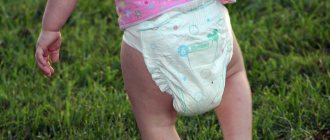What kind of stool is normal for a baby?
Frequent bowel movements in infants is normal
It should be noted that the amount of bowel movements and their nature are directly influenced by the food consumed. Basically, in the first months after birth, babies receive nutrition in the form of mother's breast milk.
But it happens that a woman after giving birth cannot breastfeed for a number of reasons. Which ones?
- insufficient milk production;
- production of milk, which for certain reasons is not suitable for the baby;
- infection of the mother (for example, HIV, etc.).
In this regard, almost from the first days of life, the baby is transferred to artificial nutrition, which may change the nature of the stool. More on this.
Choosing a diaper
You need to make sure that the diaper is the right size, otherwise it will not absorb well and will cause anxiety to the baby. Babies have very sensitive skin, and any discomfort greatly bothers them. It's best to buy several different types of diapers to see which is best. We talk in detail about what they are like here. What should you pay attention to first?
- On the packaging you will find numbers indicating the approximate weight of children: 3 – 6 kg, 4 – 9 kg, 9 – 18 kg, etc. Of course, these are approximate values, because the baby, for example, may be taller and thinner than A “standard” baby will need a diaper that is designed for a smaller baby.
If your child weighs 5 kg and you don’t know what size will suit him, try trying on “neighboring” diaper options for him - 3 - 6 kg and 4 - 9 kg. One of them will probably be preferable.
What is the stool of breastfed babies?
It is important to understand that in the first month after birth, babies have bowel movements after almost every feeding (normally 5-8 times a day). The consistency of the stool is liquid, the color is bright yellow with yellow-whitish inclusions (lumps) and a slight milky odor.
Starting from the 2nd month, the general characteristics of the stool do not change, but emptying occurs on average 3 to 5 times a day.
From the 3rd month, stools become less liquid, acquire some homogeneity, and there are significantly fewer lumps in them. The color characteristics also change - the feces become brown-yellow or yellow-green.
Your baby's stool may vary in color and consistency. It all depends on whether the newborn drinks breast milk or formula, how many months the baby is, or whether he is starting to eat solid foods. This photo guide will give you a good idea of what is normal and what is not.
Newborn stool: meconium
Greenish-black, tarry, sticky stool in your newborn's diaper during the first few days. This is meconium. It is made up of amniotic fluid, mucus, skin cells and other substances that your baby ingested in the womb. It doesn't actually smell, so you may not immediately know when it's time to change the diaper.
When your baby is two to four days old, his stool will become less sticky and lighter in color: something like army green. This transitional stool is a sign that he has begun to digest breast milk or formula.
Healthy stool while breastfeeding
If your baby is exclusively breastfed, his stool will turn yellow or slightly green and have a mushy or creamy consistency. Breastfeeding stool may look like mustard-colored cottage cheese. It often smells surprisingly sweet.
There are many shades of normal when it comes to breastfeeding bowel movements.
Healthy bottle-fed stool
Formula-fed babies have looser stools that are often similar in color and texture to peanut butter. It can range from brown or yellow-brown to green-brown. Formula-fed stool smells more.
Dark green or black stool
If you give your baby an iron supplement, his stool may turn dark green or almost black. This doesn't happen often, but it is a completely normal variation.
If your baby is more than a few days old, his poop looks blackish, and he is not taking an iron supplement, see a doctor as soon as possible. In rare cases, this may be a sign of bleeding in the baby's digestive system. This is unlikely to happen to your child, but you should check just in case.
If there are black specks in your infant's stool, it may be a sign that he is ingesting blood from cracked and bleeding nipples. The blood turns black when your baby digests it.
Stool when baby eats solids
Once your baby starts eating solid foods, you will quickly notice changes in his behavior, especially if he is breastfed. The stool will become brown or dark brown in color and thicker than peanut butter, but still soft. There is also less of it.
You may notice that your baby's stool takes on the color of the food you give him. For example, if you feed him carrots, his stool may be orange.
Stool with partially digested food
Sometimes there may be identifiable bits of food in your baby's stool, especially if you are weaning your baby. Don't worry! Your baby is still learning to chew and his digestive system is still developing, so it's normal for some food to pass through his body without being fully digested.
If your baby consistently contains undigested food in his stool, it's worth talking to your doctor. He will check that your baby's intestines are working properly and that he is getting all the nutrients he needs.
Diarrhea
It is not uncommon for healthy children to pass loose stools from time to time. But if this happens several times, he may have diarrhea. The stool may be yellow, green, or brown and may leak from the diaper.
Diarrhea can be a sign of infection or allergy, and if it lasts for a while without treatment, it can lead to dehydration. If your child has watery stools for more than one or two days, contact your pediatrician.
Constipation
If your baby's stools are hard and like small pebbles, it is likely that he is constipated. Your baby may be visibly uncomfortable when he poops, and the poor thing may even bleed from irritation.
Constipation is common in babies who are introduced to complementary foods and is usually nothing to worry about. But in some cases, constipation can be a sign of dehydration, food allergies, or illness.
Stool with mucus
Greenish stool with mucus in it. It sometimes occurs when a child is particularly drooling, as the mucus in the saliva often remains undigested. This can also happen when your baby has a cold, as they will naturally produce more mucus.
However, mucus in the stool can also be a sign of infection or allergy. If this happens for a few days or your child has any other symptoms, see your doctor to rule out any problems.
Bloody stool
If you're having a girl, you may notice a few spots of blood in her diaper a few days after birth. This happens due to the surge of hormones your body experiences during pregnancy, which in turn stimulates your baby's uterus to get a period. This is completely normal and there is no reason to worry.
In boys and girls, after the first few days, bright red blood may appear in baby's stool for several reasons. For example, constipation or diaper rash may irritate your baby's bottom and cause bleeding. Or your baby may swallow some blood if you breastfeed him with cracked nipples.
While blood in your baby's diaper doesn't necessarily mean he's sick, it's always best to get it checked. Sometimes this can be a sign of an infection, allergy, or problem with your baby's digestive system.
What happens to a baby's stool during the introduction of complementary foods?
Stool color isn't the only warning sign
From the 4th to the 6th month of birth, additional foods should be included in the baby’s diet. This helps to gradually adapt his gastrointestinal tract to more “adult” food.
Due to the introduction of complementary foods, the baby's stool changes its characteristics; it becomes darker and more mush-like.
As a rule, after the introduction of additional nutrition in children who previously suffered from constipation, bowel movements return to normal.
The baby begins to drink juices and eat vegetable and fruit purees. Pumpkin, apple, peach and plum, which are contained in baby foods, contain enough pectin and fiber that optimize the functioning of the child’s gastrointestinal tract. In the period from 4 to 6 months, bowel movements can already be once a day.
How to eliminate constipation in infants?
In the first months, infants have loose stools - this is the norm!
It should be remembered that the state of the baby’s gastrointestinal tract depends on the nursing mother’s consumption of certain foods. The first thing a woman should pay attention to is her own diet.
If it contains enough vegetables and fruits, then the intestines of both mother and baby will work normally.
However, it is worth excluding foods that affect the accumulation of gases (peas, grapes, cucumbers, beans and cabbage). If a young nursing mother still uses them, then there is a risk of intestinal colic in the baby.
Many women after childbirth (and during pregnancy) have problems with bowel movements. In such cases, it is useful to drink 200-300 ml of purified cool water on an empty stomach in the morning and eat 4-5 prunes; this will help normalize digestion in the mother and, as a result, in the baby.
Also, to restore a normal environment in the intestines, a nursing woman is prescribed drugs with bifidobacteria and lactobacilli. They are able to normalize the state of intestinal microflora.
Some women are prescribed iron supplements after delivery to increase hemoglobin levels. Their use can also cause constipation in both the new mother and the child.
When to seek medical help?
Black stool in babies is not necessarily a sign of illness, but you should talk to your doctor if the problem persists. The color usually returns to normal after a few days, but if it doesn't, it's time to see a doctor.
The doctor will confirm whether there is indeed blood in the stool. The specialist will also examine the outside of the anus to determine the true cause of the bleeding. Sometimes a rectal examination is performed to confirm the diagnosis.
Your doctor may recommend further testing if you are unsure about the cause of the bleeding. A colonoscopy will be ordered to examine the interior of the lower intestine.
How to deal with constipation in children receiving artificial nutrition?
Dysbacteriosis as a cause of green stools
Often, the use of some artificial formulas for newborns can lead to problems with stool. In these cases, consultation with specialists regarding changing the mixture is recommended.
Often, when this problem occurs, the doctor prescribes another mixture containing lacto-, bifidobacteria and prebiotics that stimulate the baby’s gastrointestinal tract. Sometimes fermented milk mixtures are prescribed.
When should you see a doctor and how to help your child?
To know how to help your child and how to improve bowel movements, you need to accurately identify the cause of the disorders. It is not always obvious and easy to define.
The child's body is still weak, and his health is very fragile. Therefore, it is better not to take risks by self-medicating, but to immediately consult a doctor. It is especially dangerous to prescribe medications to a child on your own. Some drugs can cause not only allergies, but also serious health problems for the baby.
The best help for a child is a timely examination and prescription of therapy from a competent specialist. The primary diagnosis includes an examination and a general blood and stool test. If necessary, other types of tests and additional examinations are prescribed.
For minor violations, it may be enough to adjust the diet or change the formula. Other cases may require serious treatment.
What is recommended to give to babies under 1 year of age to avoid constipation?
In addition to basic feeding (breastfeeding or bottle feeding), it is necessary to saturate the baby’s body with water. Its amount depends on the age of the baby:
- up to 3 months you need up to 50 ml;
- from 3 to 6 months - up to 100 ml per day.
If the apartment is very warm or too dry, if it is hot or stuffy outside, then the amount of water given to the baby should be increased.
If constipation in a baby occurs quite often, then the pediatrician, as a rule, prescribes drugs with lacto- and bifidobacteria, intended specifically for babies. They help improve digestion and normalize intestinal microflora.
What to do if your baby is constipated?
Not only the consistency matters, but also the smell
It is important to follow the rules for preventing stool retention. This:
- placing the baby on his tummy before feeding;
- saturating the body with water. Before meals you need to serve water in small quantities;
- tummy massage. To do this, you need to place your palm on the baby’s tummy and make smooth movements in a circle clockwise, while placing emphasis by lightly pressing on the left iliac region. But! There is no need to do this immediately after feeding, so as not to provoke vomiting.
After the massage, you need to press the child’s legs bent at the knees to his tummy, you need to do this 5-8 times. This is a kind of exercise that helps facilitate the process of passing feces.
If all the above methods did not give the desired result, then you should do an enema. However, you need to remember that this is often not recommended to avoid intestinal atony.
Attention! The use of a gas outlet tube in infants for stool retention is not recommended, since it can only release gases accumulated in the intestines and will not relieve the underlying problem. Also, using this “method” can cause some discomfort to the baby, which in this case is completely unnecessary for him.
What other problems with stool can occur in babies under 1 year of age?
Disturbance of intestinal flora (dysbacteriosis)
Since the intestinal microflora at this age is not yet fully formed, the likelihood of this pathological condition increases. Signs of dysbacteriosis are: too frequent stools (10-12 times a day), the color of the stool is green, the smell is sour and putrid. A stool test for dysbacteriosis will help confirm or refute the diagnosis.
Due to the disruption of the environment in the intestines, there is a shortage of lacto- and bifidobacteria, which are intended for the complete digestion of food. As a result, the baby experiences a slight increase in weight, which, however, does not correspond to the norm.










